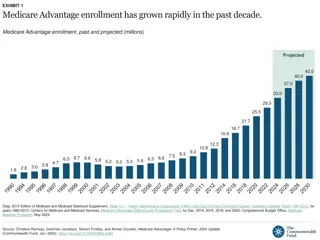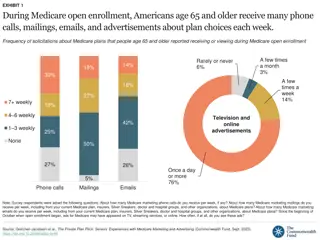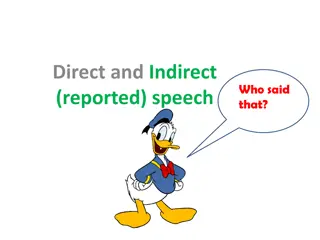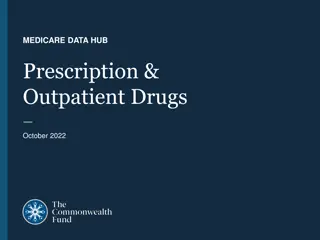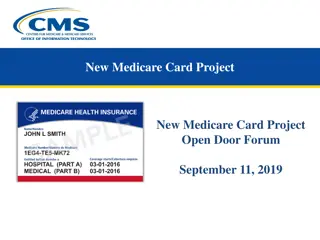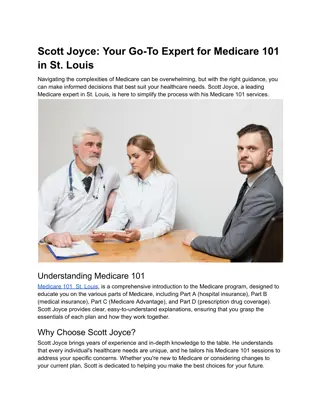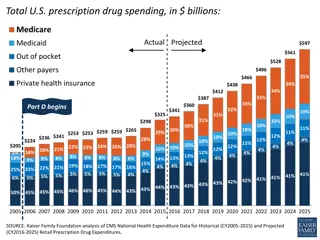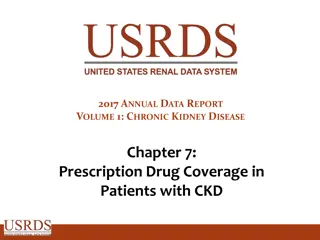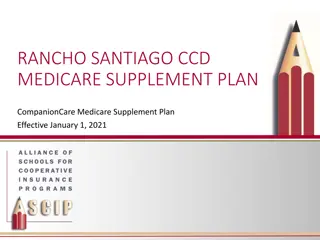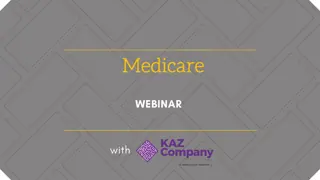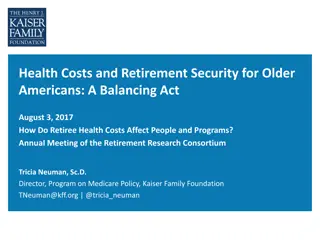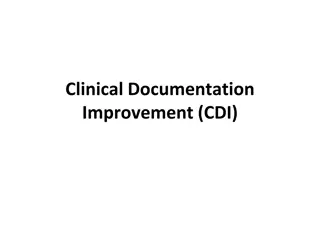Speech Therapy Guidelines and Medicare Regulations Overview
This content provides detailed information on writing person-centered functional goals in speech therapy, emphasizing SMART goals and best practices. It covers course descriptions, objectives, and Medicare regulations related to speech therapy services. The importance of reasonable and necessary evidenced-based practices in therapy services is highlighted, focusing on the Medicare Benefit Policy Manual and National Coverage Determinations. Indications for speech therapy services are outlined, including necessary treatment for communication and swallowing disorders. Overall, the content serves as a comprehensive guide for speech therapists navigating goal-setting, regulations, and evidence-based practices in the field.
Download Presentation

Please find below an Image/Link to download the presentation.
The content on the website is provided AS IS for your information and personal use only. It may not be sold, licensed, or shared on other websites without obtaining consent from the author. Download presentation by click this link. If you encounter any issues during the download, it is possible that the publisher has removed the file from their server.
E N D
Presentation Transcript
SLP5 WRITING PERSON CENTERED FUNCTIONAL GOALS Renee Kinder, MS, CCC-SLP, RAC-CT, Director of Clinical Education for Encore Rehabilitation KSHA 2017 1
Course Description Are you writing SMART goals? Attend this course to learn best practices for creating functional and measurable goals that are specific, measurable, attainable, realistic and timely. Course will also include case studies for rehab based and maintenance-based care (Intermediate) KSHA 2017 2
Course Objectives The learner will be able to: 1) describe what it means to write a SMART goal; 2) demonstrate ability to create short term objectives and long-term goals for rehab- based and maintenance-based care; and 3) explain methods for progression, advancement and downgrading of goals This session is pre-recorded. Attendees will view the video recorded session. The session moderator will accept questions for the speaker at the end of the session and attendees will receive the speaker s responses after the conference KSHA 2017 3
Know your REGULATIONS Medicare Benefit Policy Manual Chapter 15 Section 220 National Coverage Determinations Local Coverage Determinations Regional Specific KSHA 2017 4
MEDICARE BENEFIT POLICY MANUAL CHAPTER 15 REASONABLE AND NECESSARY KSHA 2017 5
Indications for Speech Therapy Services Speech-language pathology services are those services provided within the scope of practice of speech-language pathologists Necessary for the diagnosis and treatment of speech and language disorders, which result in communication disabilities and for the diagnosis and treatment of swallowing disorders (dysphagia) Regardless of the presence of a communication disability. (See CMS Publication 100-03, Medicare National Coverage Determinations (NCD) Manual, Part 3, Section 170.3) (CMS Publication 100-02, Medicare Benefit Policy Manual, Chapter 15, Section 230.3(A)) KSHA 2017 6
Reasonable and Necessary Evidenced Based Practice The services shall be considered under accepted standards of medical practice to be a specific and effective treatment for the patient's condition. Acceptable practices for therapy services are found in: Medicare manuals (such as this manual and Publications 100-03 and 100-04), Contractors Local Coverage Determinations (LCDs and NCDs are available on the Medicare Coverage Database: http://www.cms.hhs.gov/mcd and Guidelines and literature of the professions of physical therapy, occupational therapy and speech-language pathology. To be considered reasonable and necessary, the following conditions must be met: (CMS Publication 100-02, Medicare Benefit Policy Manual, Chapter 15, Section 220.2(B)) KSHA 2017 7
Reasonable and Necessary Complexity and Sophistication The services shall be of such a level of complexity and sophistication or the condition of the patient shall be such that the services required can be safely and effectively performed only by a qualified therapist Services that do not require the performance or supervision of a therapist are not skilled and are not considered reasonable or necessary therapy services, even if they are performed or supervised by a qualified professional. If the contractor determines the services furnished were of a type that could have been safely and effectively performed only by or under the supervision of such a qualified professional, it shall presume that such services were properly supervised when required. However, this presumption is rebuttable, and, if in the course of processing claims it finds that services are not being furnished under proper supervision, it shall deny the claim and bring this matter to the attention of the Division of Survey and Certification of the Regional Office. To be considered reasonable and necessary, the following conditions must be met: (CMS Publication 100-02, Medicare Benefit Policy Manual, Chapter 15, Section 220.2(B)) KSHA 2017 8
Reasonable and Necessary Medical Diagnoses While a beneficiary's particular medical condition is a valid factor in deciding if skilled therapy services are needed, a beneficiary's diagnosis or prognosis should never be the sole factor in deciding that a service is or is not skilled. The key issue is whether the skills of a qualified therapist are needed to treat the illness or injury, or whether the services can be carried out by nonskilled personnel. See item C for descriptions of skilled (rehabilitative) services. To be considered reasonable and necessary, the following conditions must be met: (CMS Publication 100-02, Medicare Benefit Policy Manual, Chapter 15, Section 220.2(B)) KSHA 2017 9
Reasonable and Necessary Determining Appropriate Frequency and Duration There must be an expectation that the patient's condition will improve significantly in a reasonable (and generally predictable) period of time, or the services must be necessary for the establishment of a safe and effective maintenance program required in connection with a specific disease state. In the case of a progressive degenerative disease, service may be intermittently necessary to determine the need for assistive equipment and/or establish a program to maximize function (see item D for descriptions of maintenance services); and The amount, frequency, and duration of the services must be reasonable under accepted standards of practice. The contractor shall consult local professionals or the state or national therapy associations in the development of any utilization guidelines. KSHA 2017 10
CODING: YOUR FIRST DEFENSE KSHA 2017 11
Coding- Keeping Control YOUR ST CLAIM EMR BOM PAYER KSHA 2017 12
Documentation: Evaluation CPT Codes KSHA 2017 13
92610: Evaluation of Oral & Pharyngeal Swallowing Function Medicare Benefit Policy Manual (MBPM), Dysphagia Defined: Dysphagia, or difficulty in swallowing, can cause food to enter the airway, resulting in coughing, choking, pulmonary problems, aspiration or inadequate nutrition and hydration with resultant weight loss, failure to thrive, pneumonia and death. It is most often due to complex neurological and/or structural impairments including head and neck trauma, cerebrovascular accident, neuromuscular degenerative diseases, head and neck cancer, dementias, and encephalopathies. For these reasons, it is important that only qualified professionals with specific training and experience in this disorder provide evaluation and treatment (1). MBPM, Swallowing Assessment Inclusions: Swallowing assessment and rehabilitation are highly specialized services. The professional rendering care must have education, experience and demonstrated competencies. Competencies include but are not limited to: Identifying abnormal upper aerodigestive tract structure and function Conducting an oral, pharyngeal, laryngeal and respiratory function examination as it relates to the functional assessment of swallowing Recommending methods of oral intake and risk precautions Developing a treatment plan employing appropriate compensations and therapy techniques (2). KSHA 2017 14
2014 Evaluation Codes Defined 92521 Evaluation of speech fluency (e.g., stuttering, cluttering) 92522 Evaluation of speech sound production (e.g., articulation, phonological process, apraxia, dysarthria) 92523 Evaluation of speech sound production (e.g., articulation, phonological process, apraxia, dysarthria); with evaluation of language comprehension and expression (e.g., receptive and expressive language) 92524 Behavioral and qualitative analysis of voice and resonance KSHA 2017 15
Can new codes be billed together same day? The CPT Handbook does not include language to restrict an SLP's ability to bill these codes together because there are circumstances when it is appropriate for a patient to be evaluated for multiple disorders on the same day. Note- In those cases, documentation should clearly reflect a complete and distinct evaluation for each disorder. KSHA 2017 16
One Hour Time Based Eval Codes 92626- Evaluation of Auditory Rehabilitation Status; First Hour 92627 Evaluation of Auditory Rehabilitation Status; Each addition 15 minutes 96125- Standardized cognitive performance testing (e.g., Ross Information Processing Assessment) per hour of a qualified health care professional's time, both face-to-face time administering tests to the patient and time interpreting these test results and preparing the report. Per Hour. 96105- Assessment of Aphasia (includes assessment of expressive and receptive speech and language function, language comprehension, speech production ability, reading, spelling and/or writing ex. by BDAE) with interpretation and report- Per Hour 92607 Evaluation for prescription for speech-generating AAC device face to face with the patient- First Hour. 92608 Evaluation for prescription for speech-generating AAC device face to face with the patient- Each additional 30 minutes. KSHA 2017 17
Is my documentation time included? Medicare Part A MDS Section O: Rules for Recording Treatment Minutes (RAI Manual, Chapter 3, Section O; directly-quoted text is in italics) The therapist's time spent on documentation or on initial evaluation is not included (Page O 17) The therapist's time spent on subsequent reevaluations, conducted as part of the treatment process, should be counted (Page O 17) http://www.asha.org/Practice/reimbursement/medicare/Medicare-Guidance-for-SLP- Services-in-Skilled-Nursing-Facilities/ Medicare Part B 96105 and 96125 billing for Medicare Part B beneficiaries follows the definition of codes set forth per LCD definitions therefore allowing ST to account for interpretation time in assessment. KSHA 2017 18
Case Studies Mr. Smith is admitted to SNF following acute onset of RCVA requiring standardized measure of language and cognitive functions 96105- Assessment of Aphasia AND/OR 96125- Standardized Cognitive Performance Testing ** Think about clinical appropriateness when selecting evaluation type** Will I mentally fatigue if I assess all areas day one? After 6 weeks of intensive treatment you determine he will require speech generating AAC device to meet communicative needs. Use 92607- Evaluation for prescription for speech generating AAC Device KSHA 2017 19
Case Studies Mr. Smith is referred for evaluation due to stuttering. He presents with Advanced Dementia. Remember- Dysfluency services are not typically covered by Medicare, nor would interventions aimed at fluency be supported by Evidenced Based Practice Patterns. Use 92523 Eval of Speech Sound Production with Eval of Language Comprehension and Expression AND/OR 96105- Assessment of Aphasia if patterns follow diagnostic criteria for Primary Progressive Aphasia associated with Dementia OR 96125- Standardized Cognitive Performance Testing inclusive of Dementia Staging Tools when disease process follows AD type Dementia. KSHA 2017 20
DOCUMENTING: PLAN OF CARE REQUIREMENTS KSHA 2017 21
Evaluation Defined An EVALUATION is a separately payable comprehensive service provided by a clinician, as defined above, that requires professional skills to make clinical judgments about conditions for which services are indicated based on objective measurements and subjective evaluations of patient performance and functional abilities (BASELINES). An Evaluation is warranted e.g., for a new diagnosis (change from plof). These evaluative judgments are essential to development of the plan of care, including goals and the selection of interventions. KSHA 2017 22
Documentation Overview: Plan of Care (POC) Requirements Order or Referral Clear distinction for Evaluation/Re-evaluation or Screening Beneficiary's History and the Onset or Exacerbation Date of the current disorder. History in conjunction current symptoms must establish support for additional treatment. Prior Level of Functioning should be documented Baseline abilities should be documented PLOF + Baseline establish the basis for the therapeutic interventions. Plan, Goals (realistic, long-term, functional goals) Duration of therapy, Frequency of therapy, and definition of the Type of Service. Diagnostic and assessment testing services to ascertain the type, causal factor(s) should be identified during the evaluation. Clarify if plan is anticipated to be rehabilitative/restorative or maintenance based KSHA 2017 23
STEPS Step 1: Order Received Step 2: Screen Step 3: Evaluate and Determine if Skilled Intervention is Necessary Step 4: Establish POC Step 5: Write Clarification Order Step 6: Get POC Certified Step 7: Re Eval as appropriate Step 8: Recertify when necessary KSHA 2017 24
STEP 1: Order/Referral Needed for initial evaluation MD signature on POC acts as certification/clarification of services after evaluation New signature/certification needed for: Any significant updates to POC affecting LTG (will require re-eval or recertification) Addition of new interventions not included on initial plan. Example-ST begins services for dysphagia alone, as resident progresses with laryngeal function further eval is warranted for voice and motor speech PT completes initial POC for wound care and progresses patient to point where standard PT eval is reasonable and necessary Recertification of POC KSHA 2017 25
STEP 2: Screening Screening assessments are non-covered and should not be billed. The initial screening assessments of patients or regular routine reassessments of patients are not covered. Think .. Screening Tells you Eval or Not Eval No Clinical Judgments or Skilled Recommendations Should be Made from Screen Alone KSHA 2017 26
STEP 3: Evaluation The order or referral for the evaluation and any specific testing in areas of concern should be designated by the referring physician in consultation with the therapist. The documentation of the evaluation or re-evaluation by the therapist should demonstrate that an actual hands-on assessment occurred to support the medical necessity for reimbursement of the evaluation or re-evaluation. DETERMINES NEED FOR SKILL KSHA 2017 27
Diagnostic Testing Diagnostic and assessment testing services to ascertain the type, causal factor(s) should be identified during the evaluation. Includes documentation of standardized and non-standardized functional assessment tools. KSHA 2017 28
Documenting ability to learn Documentation is expected to support the ability of the beneficiary to learn and retain instruction. Absence of such documentation may result in a denial of services. If the patient has questionable cognitive skills, a brief cognitive-communication assessment should be performed in order to establish the patient's learning ability. The brief cognitive assessment may also determine the need for more comprehensive cognitive performance testing. KSHA 2017 29
Baseline *Must be documented* The initial assessment establishes the baseline data necessary for evaluating expected rehabilitation potential, setting realistic goals, and measuring communication status at periodic intervals. Methods for obtaining baseline function should include objective or subjective baseline diagnostic testing (standardized or non-standardized) followed by interpretation of test results, and clinical findings. Goals should not be created for areas which do not have documented baseline measures, hence DNT or Will not be addressed during POC should not be used for target areas KSHA 2017 30
Prior Level of Function *Must be documented* The residents prior level of function (PLOF) refers to the functional level of independence prior to onset of decline which necessitated need for skilled therapy screening, and if deemed necessary, further evaluation and skilled intervention. Documented PLOF must reflect and align with skilled need. KSHA 2017 31
Documenting Change from PLOF to Baseline The Difference between baseline and plof measures should assist the therapist with determining appropriate frequency and duration of care. Greater changes may require more intensive interventions Lower Levels of Support Needed for Success Greater Level of Support Needed for Success KSHA 2017 32
Step 4: Establish POC Establish POC : - Goals - Frequency - Duration - Comparison of PLOF and Evaluation Baseline - Deficits that require skilled care MUST have goals - No Goal = No Treatment Can Occur - State whether the plan is REHAB/RESTORATIVE or MAINTENANCE BASED KSHA 2017 33
Medical History Onset or Exacerbation Date In conjunction current symptoms Onset/Exacerbation Date: the date of the functional change which as a result of dx indicated the need for skilled care Chronic Conditions: May not be the date of dx for condition, however related to exacerbation of dx process New Conditions: CVA/TBI will be date of new insult Provide correlation of why new onset has resulted in symptoms requiring your unique skilled services. KSHA 2017 34
Rehab Therapy Defined Rehabilitative/Restorative therapy includes services designed to address recovery or improvement in function and, when possible, restoration to a previous level of health and well-being (i.e. PLOF). Therefore, evaluation, re-evaluation and assessment documented in the Progress Report should describe objective measurements which, when compared, show improvements in function, decrease in severity or rationalization for an optimistic outlook to justify continued treatment. KSHA 2017 35
Maintenance Programs Defined MAINTENANCE PROGRAM (MP) means a program established by a therapist that consists of activities and/or mechanisms that will assist a beneficiary in maximizing or maintaining the progress he or she has made during therapy or to prevent or slow further deterioration due to a disease or illness. KSHA 2017 36
Maintenance Programs The services of a maintenance program themselves are not covered. However, the development of a functional treatment plan for patient maintenance including evaluation, plan of treatment, and staff and family training, is covered, but it must require the skills of an SLP, and be a distinct and separate service which can only be done safely by a SLP KSHA 2017 37
The Jimmo Affect. Cant I treat anyone now? Clarified with Jimmo versus Sebelius Final Ruling: Establishment or Design of a Maintenance Program Delivery/Performance of a Maintenance Program Delivery of Rehabilitative/RestorativeTherapy KSHA 2017 38
Maintenance Sample: VOICE Motor Speech/Voice: Skilled ST services may be deemed reasonable and necessary in order to maintain vocal clarity and intensity for an individual with Parkinson s Disease in order to continue training via use of Lee Silverman Voice Therapy (LSVT) techniques for maintenance. Note: transition from therapy services aimed at increasing function to maintenance therapy should occur following therapist/resident determination that max benefit has been achieved at a particular communication level (word, phase, sentence, structured conversation, or spontaneous conversation) with maintenance interventions being aimed at continued communication success (pending modifications which may be warranted secondary to typical declines with disease progression) at this level at a decreased intensity from prior services. Why can these services not be transitioned to a non-skilled professional such as a CNA or Nurse for restorative/maintenance? Due to the progressive nature of vocal and motor speech system changes, the skilled eye of an SLP is needed to develop and continue vocal function protocol and conduct differential diagnosis when changes occur across various systems of communication with disease progression. KSHA 2017 39
Maintenance Sample: Cog- Language Auditory Comprehension/Cognition: Skilled ST services may be deemed reasonable and necessary in order to maintain auditory comprehension skills in the following instances: An individual s/p new neurological insult following a period of intensive skilled ST interventions aimed at increasing abilities to comprehend language and perform cognitive tasks (sequencing, problem solving) at the highest level possible continued services for maintenance may be warranted to continue skilled therapeutic tasks for high level tasks in order to prevent functional declines in preparation for d/c to prior living environment while continued services are being provided by PT/OT. Interventions provided as maintenance versus rehabilitation in nature are to be provided at a decreased intensity from initial services. Why can these services not be transitioned to a non-skilled professional? Skilled interventions for high level auditory comprehension tasks including ability to follow multi-step ADL/IADL commands; comprehend conversational interactions; sequence during tasks and complete functional problem solving with others requires administration of tasks which cannot be performed or conducted by a non-skilled professional. In addition, tasks in the above instance will require periodic modification secondary to anticipated increased success with PT/OT sessions which will change task segmentation and progression of ADLs and IADLs. Remember- cases such as described may also move from rehabilitative in nature to maintenance to return to rehabilitative in nature secondary to increased physical abilities necessitating the need for higher level cognitive and language learning. KSHA 2017 40
Maintenance Sample: Dysphagia Skilled therapy services may be deemed reasonable and necessary in order to maintain adequate swallow functions for pleasure feeding regiment which is clearly defined and agreed upon by members of the interdisciplinary team in conjunction with the resident and family members. Why can these services not be transitioned to a non-skilled professional? Per the Medicare Benefit Policy Manual (2014): Swallowing assessment and rehabilitation are highly specialized services. The professional rendering care must have education, experience and demonstrated competencies. Competencies include but are not limited to: identifying abnormal upper aerodigestive tract structure and function; conducting an oral, pharyngeal, laryngeal and respiratory function examination as it relates to the functional assessment of swallowing; recommending methods of oral intake and risk precautions; and developing a treatment plan employing appropriate compensations and therapy techniques. Above competencies cannot be performed by a non-skilled professional in an individual presenting with dysphagia severity which would warrant pleasure feedings. Note- need for pleasure feedings must be necessitated by a dysphagia secondary to oral, pharyngeal, and/or upper 1/3rd of the esophageal phase. Services for maintenance in end stage of dementia secondary to presence of tongue thrust as root cause or esophageal impairments/strictures/blockages in the lower 2/3rd of the esophagus would not warrant services as they are not covered for the Medicare Beneficiary. KSHA 2017 41
Individuals with Chronic Conditions Rehabilitative therapy may be needed, and improvement in a patient s condition may occur, even when a chronic, progressive, degenerative, or terminal condition exists. For example, a terminally ill patient may begin to exhibit self-care, mobility, and/or safety dependence requiring skilled therapy services. The fact that full (full movement from baseline to plof) or partial recovery is not possible does not necessarily mean that skilled therapy is not needed to improve the patient s condition or to maximize his/her functional abilities. The deciding factors are always whether the services are considered reasonable, effective treatments for the patient s condition and require the skills of a therapist, or whether they can be safely and effectively carried out by non-skilled personnel. KSHA 2017 42
Goals/Treatment Measures REALISTIC/LONG TERM/FUNCTIONAL There should be an expectation of measurable functional improvement. Measureable component (percentile) needs to be attached to all short and long term goals Functional component (in order to ) needs to be attached to all short and long term goals. SUB-TASK functional impairment areas in order to measure more specific changes in function KSHA 2017 43
Step 5: Write Clarification Order Patient to receive skilled (insert discipline) (insert frequency) (insert duration) in order to (insert reason) KSHA 2017 44
Step 6: Certification of Eval/POC CERTIFICATION is the Physician s/Non Physician Practitioner s (NPP) approval of the plan of care (evaluation). Certification requires Signature must be from the physician or NPP Timely certification occurs within 30 days A dated signature on the plan of care or some other document that indicates approval of the plan of care When initial cert expires, a recert must then be completed certified within 30 days (needs MD signature and date which can be added as receipt date). KSHA 2017 45
GOAL BUILDING KSHA 2017 46
Goals/Treatment Measures REALISTIC/LONG TERM/FUNCTIONAL There should be an expectation of measurable functional improvement. Measureable component (percentile) needs to be attached to all short and long term goals Functional component (in order to ) needs to be attached to all short and long term goals. SUB-TASK functional impairment areas in order to measure more specific changes in function KSHA 2017 47
S.M.A.R.T. GOALS Specific Measurable Attainable Realistic Timely KSHA 2017 48
SPECIFIC A specific goal has a much greater chance of being accomplished than a general goal. To set a specific goal you must answer the six W questions: *Who: Who is involved? *What: What do I want to accomplish? *Where: Identify a location. *When: Establish a time frame. *Which: Identify requirements and constraints. *Why: Specific reasons, purpose or benefits of accomplishing the goal. KSHA 2017 49
MEASURABLE There must be tangible criteria for measuring progress toward the attainment of each goal you set. To determine if a goal is measurable, ask questions such as How much? How many? How will you know when it is accomplished? KSHA 2017 50




